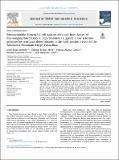| dc.contributor.author | Rojas-Jiménez, Jorge | |
| dc.contributor.author | Brenes-Mora, Esteban | |
| dc.contributor.author | Alcázar García, Paloma Elizabeth | |
| dc.contributor.author | Arguedas, Randall | |
| dc.contributor.author | BARQUERO-CALVO, ELIAS | |
| dc.date.accessioned | 2020-06-25T20:12:47Z | |
| dc.date.available | 2020-06-25T20:12:47Z | |
| dc.date.issued | 2018-09-27 | |
| dc.identifier.uri | http://hdl.handle.net/11056/17656 | |
| dc.description.abstract | Objectives
The main objective of this study was to analyse the antimicrobial susceptibility profile of Escherichia coli isolates obtained from faecal samples of free-ranging Baird’s tapirs (Tapirus bairdii) in the northwestern region of the Talamanca Mountain Range, Costa Rica.
Methods
Faecal samples were collected by opportunistic search of the study area from February–September 2017 during seven field expeditions. Escherichia coli isolates were recovered using selective and differential MacConkey agar medium and were subjected to biochemical identification and antimicrobial susceptibility testing using a VITEK®2 Compact automated system and the AST-N279 card.
Results
A total of 60 E. coli isolates were obtained from 63 faecal samples. Following evaluation of nine different antimicrobial classes, 98% (59/60) of the isolates were characterised as pansusceptible; only 1 isolate presented resistance to nalidixic acid.
Conclusion
We propose that the commensal intestinal microbiota of free-ranging Baird’s tapirs in this area remains isolated from antibiotic selective pressure, probably because seven different protected areas converge, thus giving a possible low anthropogenic activity to the region. | es_ES |
| dc.description.abstract | Objetivos El principal objetivo de este estudio fue analizar el perfil de susceptibilidad antimicrobiana de los aislados de Escherichia coli obtenidos de muestras fecales de dantas de Baird (Tapirus bairdii) en libertad en la región noroccidental de la cordillera de Talamanca (Costa Rica). Métodos Se recogieron muestras fecales mediante una búsqueda oportunista en la zona de estudio entre febrero y septiembre de 2017 durante siete expediciones sobre el terreno. Se recuperaron aislamientos de Escherichia coli utilizando un medio de agar selectivo y diferencial MacConkey y se sometieron a identificación bioquímica y a pruebas de susceptibilidad antimicrobiana utilizando un sistema automatizado VITEK®2 Compact y la tarjeta AST-N279. Resultados Se obtuvo un total de 60 aislamientos de E. coli de 63 muestras fecales. Tras la evaluación de nueve clases diferentes de antimicrobianos, el 98% (59/60) de las cepas se caracterizaron como panaceptables; sólo una cepa presentó resistencia al ácido nalidíxico. Conclusión Proponemos que la microbiota intestinal comensal de los tapires de Baird en libertad en esta zona permanezca aislada de la presión selectiva de los antibióticos, probablemente debido a que convergen siete zonas protegidas diferentes, lo que da una posible baja actividad antropogénica a la región. | es_ES |
| dc.language.iso | eng | es_ES |
| dc.publisher | Elsevier | es_ES |
| dc.rights | Acceso abierto | es_ES |
| dc.rights.uri | http://creativecommons.org/licenses/by-nc-nd/4.0/ | |
| dc.source | Journal of Global Antimicrobial Resistance Vol. 16 : 140-143 (2019) | es_ES |
| dc.subject | COSTA RICA | es_ES |
| dc.subject | AREAS DE PROTECCION | es_ES |
| dc.subject | ESCHERICHIA COLI | es_ES |
| dc.subject | ANTIBIOTICOS | es_ES |
| dc.subject | ANTIMICROBIAL RESISTANCE | es_ES |
| dc.subject | TAPIRUS BAIRDII | es_ES |
| dc.subject | DANTA | es_ES |
| dc.title | Pansusceptible Escherichia Coli isolates obtained from faeces of free-ranging baird's tapirs (Tapirus Bairdii) suggests a low selective pressure for resistance determinants in the Northwestern Region of the Talamanca Mountain Range, Costa Rica | es_ES |
| dc.type | http://purl.org/coar/resource_type/c_6501 | es_ES |
| dc.description.procedence | Escuela Medicina Veterinaria | es_ES |
| dc.identifier.doi | 10.1016/j.jgar.2018.09.014 | |


